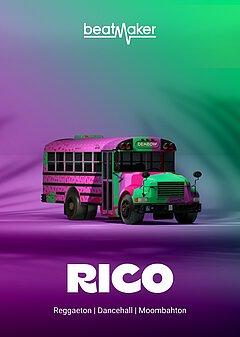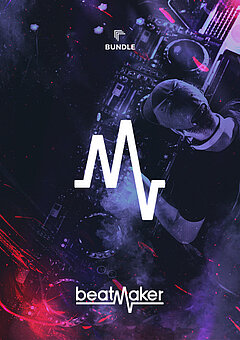How to Make a Dembow Groove
Build punchy, snapping rhythms and master the production behind one of the hottest latin genres in the world.
JUNE 25TH, 2022
With this simple tutorial, you will find an endless palette of reggaetón, moombahton and pop beats to dial up the energy in moments — no more searching for samples.
Building off the riddim
Dembow by itself is not a genre — it’s a riddim (not to be confused with the offshoot of dubstep featuring heavy sound design, often with metallic resonances). Riddim is a Jamaican pronunciation of the word “rhythm”, and loosely refers to the instrumentation or musical accompaniment of a song, typically containing a specific rhythm and an implied set of instruments to perform it. In the case of dembow, this is the classic “boom - - chick boom - chick -” (with the hyphens representing rests).
This is the pulse of dembow. Ideally you’ll have plenty of variation, including parts where the drum groove disappears completely, but this rhythm is weaved throughout the majority of the song in some shape or form. During lighter sections around the song’s choruses, try giving the dembow groove to different instruments. For example, a high-passed kick and a smaller snare or clap. This gives the effect of moving the rhythm around to different parts of the ensemble, adding dimension and variety (even if you’re a fan, it only takes so long before the kick thump and snare smack get to be a bit much).
It doesn’t end here, of course — a good rhythm needs to be filled in a bit! First, start with adding in snare ghost notes, using a somewhat random pattern that varies over time, creating the impression of a live player having fun in between the main hits. When done tastefully, this alone can be enough to fill in the entire rhythm, allowing you to quickly achieve the full dembow vibe quickly.
Drum selection
Next to the rhythm itself, this is the most important part to take note of is the instrumentation of the rhythm section, specifically the drums; getting the sound right is key. For the kick, you generally want it to be unpitched, cutting the sound off before any clearly defined bass breaks through. It should also be deep, with a low end thump similar to that of a dubstep kick, though without the punchy high frequency content. This dull, round hit will form the 4-to-the-floor pulse that drives your dembow groove forward! If it feels incomplete or needs some more power, try layering a half-open hi hat on top; this will fill things out in no time!
Next comes the snare. These hits are meant to be short and tight — no tail, no obvious pitch associated with them. The tonality is almost closer to a clap in modern dembow, with an emphasis around 1kHz - 3kHz (this is a generalization, it doesn’t have to be that specific). This is a case where it’s typically best to use samples selected specifically for this purpose, as this sound is a bit difficult to create on one’s own. That said, if you find clap samples that are reasonably close to your desired sound, there are a couple things you can do to doctor them up.
One thing you can do to immediately make the snare or clap feel fatter is to add some type of dimension expander, like the one in Serum FX — the specific plugin you use doesn’t matter, but you want to make sure the sound collapses to mono without phasing (which most delay and Haas effects are known for causing). You can also use an EQ with a wide bell-curve boost, automating the frequency and gain upward slightly to produce an airy whoosh that instantly makes things feel more dynamic.
If you need the perfect tool for all things dembow, look no further than Beatmaker RICO! It contains all the samples and rhythms you need, and you can mix and match kits to your liking, giving you all the customization options you could ask for!
Placing the final pieces
Once you get the beat in place, the next step is to fill in the pieces that complete the song, and the best place to go next is the bass. You don’t need anything super complicated here, as the bass’s primary job is twofold: 1) providing the root note of the key, and 2) adding an additional rhythmic layer. The rhythmic portion can simply follow the rhythm, jumping between octaves or from the root note to the fifth of the scale. It’s possible to create a great bassline that has more intrigue to it (if you opt for this path, Virtual Bassist DANDY is a great tool to rely on), but this isn’t necessary for creating great reggaeton.
One last consideration, other than the vocals at the forefront of the arrangement, is how to mix your dembow song. This is one type of production where you can easily overcompress your drums, as you want to keep the release tails as short as possible (and compression by nature will make them longer and louder). You can also add some creative effects over the drums, such as distortion, phasing, reverb, and anything else you like to taste. For the bass, simple saturation is often plenty, but you can get much more creative than you do with the drums with compression since there are fewer dynamic constraints to consider.
Dembow mixes are simple by nature, so if you’re happy with where this all gets you, there’s no need to complicate it any further!
Wrapping up
Denbow can be an incredibly fun style to produce, in no small part because the process of going from start to finish is very straightforward. The rhythm is already partially done for you; the bassline is simple; if you choose not to, you don’t even have to use chords! When you put an idea into action, you can afford to focus on small details since the broad stroke decisions are largely handled for you. This principle can even be applied to the other riddims spread across reggaeton and other latin genres.
The flipside is that you have to add in a bit of ear candy to spice things up and set your music apart — control the sound of your drums and the space between them, and you’ll be able to get the sound you truly want. Just be willing to go the extra mile!
About the Author
Harry Lodes is a copywriter, marketing consultant and content writer for audio and ecommerce brands. He lives in the Philadelphia area, releasing Eastern/Western hybrid EDM under the artist name KAIRI hearkening back to his roots in Berklee College of Music.
Stay up to date
Sign up and we’ll send you an e-mail with product news and helpful stuff every now and then. You may unsubscribe at any time.
Defy Limits
We develop software solutions that enable people to create, consume and interact with music.



